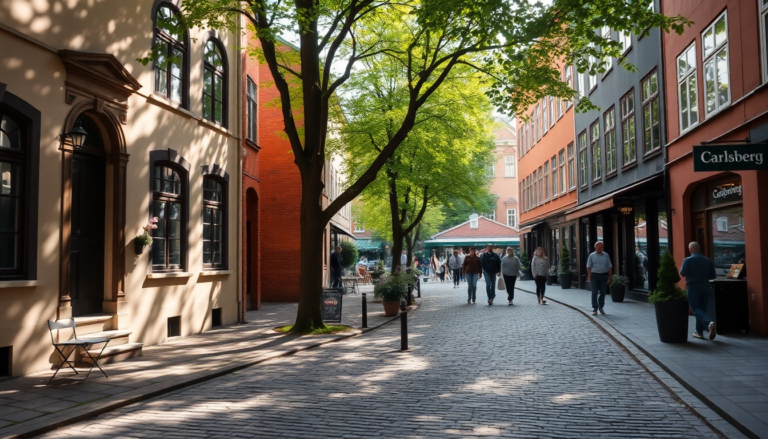Argomenti trattati
Imagine wandering through a vibrant neighborhood where history intertwines with contemporary innovation. Carlsberg, a once industrial enclave, has transformed into a captivating area that tells the story of Copenhagen’s evolution. Forget the usual tourist spots like Nyhavn or Tivoli Gardens; this is where the real essence of the city lies, away from the hustle and bustle. As I strolled through its cobblestone streets, I felt an electric mix of nostalgia and excitement—like stepping into a living museum with a pulse.
Rebirth of a historic site
Carlsberg City, as it’s now known, is a shining example of urban regeneration. Nestled amidst the remnants of 19th-century breweries and workers’ housing, this neighborhood has been meticulously transformed into a space that resonates with life and sustainability. The Danish architecture firm BRIQ has worked tirelessly since 2017 to breathe new life into this area, creating a community that values both recreation and culture. Peter Buhr, one of the co-creative directors at BRIQ, emphasized the importance of balancing three key pillars in their development: recreational spaces, cultural institutions, and commercial activity. “We aim to create not just a space, but a neighborhood with soul,” Buhr explained, and honestly, it shows.
The heart of Carlsberg’s legacy
At the core of this neighborhood lies the House of Carlsberg, which stands as a testament to the brewing legacy that started in 1847. It was here that Jacob Christian Jacobsen brewed the famous Carlsberg beer, gaining international acclaim and significantly impacting Danish culture. Although production moved to Jutland in 2008, the House remains a must-visit. Guided tours, included with the Copenhagen Card, take you through the evolution of the brand, culminating in a delightful beer tasting. Personally, I remember my first sip of their flagship lager—it was like a crisp breeze on a summer day, refreshing and full of character.
A blend of old and new
The architectural landscape of Carlsberg is just as dynamic. The former industrial buildings are not just relics; they have been transformed into chic apartments, offices, and design boutiques that showcase the best of Danish craftsmanship. The district even boasts some of the first brutalist buildings in Denmark, a bold architectural statement that contrasts beautifully with the older structures. Buhr shared that their inspiration drew from Italian towns like San Gimignano, leading to the construction of taller buildings that provide a unique skyline for Copenhagen. Seven towers now grace the area, including the tallest in the city at 120 meters high.
Exploring the vibrant streets
But let’s not forget the charm of wandering through its streets. The original cobblestones have been preserved, creating a picturesque setting for pedestrians and cyclists alike. The area is dotted with parks—25, to be exact, including the largest that was once Jacobsen’s private garden. One could easily lose track of time exploring the lush greenery, and the iconic Elephant Tower, which serves as a gateway, is a perfect photo op, symbolizing the neighborhood’s heritage. I found myself captivated by its grandeur, feeling like a kid again, eager to snap a picture for posterity.
Culinary delights and local hotspots
As you stroll through Carlsberg, culinary adventures await at every turn. The neighborhood boasts a rich tapestry of dining options, from traditional smørrebrød at Aamanns Genbo—a Michelin-recommended eatery—to the innovative vegan dishes at Beyla. The Coffee Collective is another gem, much more than just a café; it’s a cozy haven to plan your next exploration over a perfectly brewed cup. I recall sitting there, the aroma of freshly baked goods wafting through the air, and thinking, “Could life get any better?”
Convenient connections
Getting to Carlsberg City is a breeze, with the Enghave Square metro station just a stone’s throw away. The red line (M3) takes you directly to this hidden gem, while the yellow line (M2) connects seamlessly from the airport to the city. For those who prefer trains, the Carlsberg station is well-linked to Copenhagen Central Station, making it easy for anyone to access this vibrant neighborhood. And if you’re like me, a fan of public transport, the Copenhagen Card is your best friend, providing unlimited travel across the city.
Art and culture beyond Carlsberg
If you find yourself captivated by the Jacobsen family legacy, don’t miss a visit to the Glyptoteket. Founded by Carl Jacobsen, the son of the brewery’s founder, this museum showcases an impressive collection of art, including works by Gauguin and Rodin, and archaeological treasures from ancient civilizations. I remember stepping into the museum and being struck not just by the art, but by the serene atmosphere of the winter garden within—a perfect retreat from the city’s hustle.
Carlsberg is more than a neighborhood; it’s a narrative of rebirth, a blend of the old and new, and a cultural hotspot waiting to be explored. It’s a place where stories are not just told but lived, and I can’t help but think that every corner holds a secret waiting for the curious traveler to unveil.

